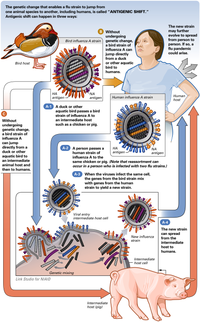
DUA buah sekolah lagi ditutup hari ini menjadikan kesemuanya empat sekolah dengan jumlah kes meningkat kepada 68 berikutan penularan tempatan Influenza A (H1N1). Ketua Pengarah Kesihatan, Tan Sri Dr Mohd Ismail Merican hari ini berkata Seri Cempaka International School di Cheras ditutup sehingga Sabtu ini manakala Sekolah Rendah Kebangsaan (SRK) Assunta 1 di Petaling Jaya ditutup selama seminggu.
=
Genetics

On April 24, the CDC determined that seven samples from suspected cases in Mexico matched the strain that had infected patients in Texas and California with no known linkages to animals or one another; the strain appeared to be spreading from human to human.[9][10] The CDC determined that the strain contained genes from four different flu viruses – North American swine influenza, North American avian influenza, human influenza, and swine influenza virus typically found in Asia and Europe – "an unusually mongrelised mix of genetic sequences."[11][12] A CDC investigative team arrived in Mexico City on April 25 to work with Mexican counterparts to study the virus.[13]
Pigs are susceptible to influenza viruses that can also infect both humans and birds, so they may act as a "mixing vessel" in which reassortment can occur between flu viruses of several species.[14][15] Reassortment is a process that happens if two different types of influenza virus infect a single cell and it can produce a new strain of influenza. This is because the virus genome is split between eight independent pieces of RNA, which allows pieces of RNA from different viruses to mix together and form a novel type of virus as new virus particles are being assembled.[16] This new strain appears to be a result of the reassortment of two swine influenza viruses, one from North America and one from Europe.[17] But the North American pig strain was itself the product of previous reassortments, and has carried an avian PB2 gene for at least ten years and a human PB1 gene since 1993.[18] These genes were passed on to the new virus.[19][20]
Gene sequences for every viral gene were made available through the Global Initiative on Sharing Avian Influenza Data (GISAID).[21][22] A preliminary analysis found that the hemagglutinin (HA) gene was similar to that of swine flu viruses present in U.S. pigs since 1999, but the neuraminidase (NA) and matrix protein (M) genes resembled versions present in European swine flu isolates. While viruses with this genetic makeup had not previously been found to be circulating in humans or pigs, there is no formal national surveillance system to determine what viruses are circulating in pigs in the U.S.[23] So far, little is known about the spread of the virus in any pig population. A preliminary analysis has also shown that several of the proteins involved in the pathophysiology of the virus are most similar to strains that cause mild symptoms in humans. This suggests that the virus is unlikely to cause severe infections similar to those caused by the 1918 pandemic flu virus or the H5N1 avian influenza.[24]
Late on May 6, Canada's National Microbiology Laboratory first completed the sequencing of the virus, publishing the result to GenBank. Samples from Mexico, Nova Scotia and Ontario had the same sequence, ruling out genetic explanations for the greater severity of the Mexican cases.[25][26]
The genetic divergence of the virus in samples from different cases has been analysed by Mike Worobey at the University of Arizona at Tucson, USA, who found that the virus jumped to humans in 2008 probably after June, and not later than the end of November[27].
=
2009 Influenza A(H1N1) pandemic
In the 2009 flu pandemic, the virus isolated from patients in the United States was found to be made up of genetic elements from four different flu viruses – North American Mexican influenza, North American avian influenza, human influenza, and swine influenza virus typically found in Asia and Europe – "an unusually mongrelised mix of genetic sequences."[13] This new strain appears to be a result of reassortment of human influenza and swine influenza viruses, in all four different strains of subtype H1N1.
Preliminary genetic characterization found that the hemagglutinin (HA) gene was similar to that of swine flu viruses present in U.S. pigs since 1999, but the neuraminidase (NA) and matrix protein (M) genes resembled versions present in European swine flu isolates. The six genes from American swine flu are themselves mixtures of swine flu, bird flu, and human flu viruses.[14] While viruses with this genetic makeup had not previously been found to be circulating in humans or pigs, there is no formal national surveillance system to determine what viruses are circulating in pigs in the U.S.[15]
On June 11, 2009, the WHO declared an H1N1 pandemic, moving the alert level to phase 6, marking the first global pandemic since 1968.[16]




























































